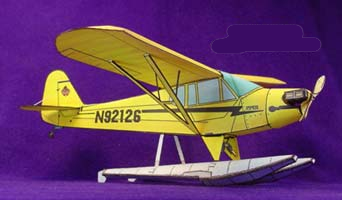BREMERTONAfter my hitch in the CCC's I returned to Penasco on November 20,
1941. My father had been to the VA Hospital again. I knew I had to do something.
I had been contributing $22.00 a month while in the CCC's. Suddenly nothing, not
even my $14.00.
There was a National Youth Administration (NYA) in place. The man in charge
of the program nationally was none other than Clinton P. Anderson. I signed up
for the Aviation Program at Highlands University at Las Vegas. While at Ft.
Sumner I had gotten a ride in a Piper J-3. I knew then I wanted to be pilot, but
I did not know how to go about it. I wound up being accepted for sheet metal and
machinist training. You were paid too, $65.00 per month!
This was my second encounter with the J-3. Just what was the J-3? She was conceived in bankruptcy and nurtured in penury, a true child of the Depression, but she grew up to be a star and to make a fortune for her backer, if not her designer. When war came the soldiers loved her, too. She initiated more gauche young men into the joys of flight than any other airplane ever; and now, as a sprightly old lady, she is still much loved. With more power to her elbow, and a fashionable "Super" to her name, she still seems young and fascinating to her swains. More later!  My instructor in sheet metal was Ralph Ciddio and Joe Romero for machine shop. Both were part of a program to prepare people for the defense industry. Elias Romero, originally from Trampas, was an instructor in wood-working and it was because of his intervention that George Vasquez and I were among the first to be sent to Seattle in April 1942 to be placed in the aircraft industry. Neither of us had more than $20.00 when we left by train from Las Vegas, New Mexico. I was sixteen. We met in the corridors of the train and cried our hearts out. When we got to Seattle we were housed in the suburb of Georgetown while the NYA made arrangements to place us. When the process took over a week, we skipped the camp, having found out that Bremerton Navy Yard was hiring sheet metal worker helpers at 65 cents an hour. We were hired to work the swing shift and found a real dump to live in for 35 cents a day. By first payday, we were completely broke. Our meals had consisted of a nickel candy bar for lunch and a candy bar and lots of water for dinner. Some people would give us part of their lunch at work sometimes. That is how I met Bill Povey. He was my supervisor and when he learned that I did not bring lunch, he just opened his lunch box, produced two sandwiches and passed one over to me. I did not even have a chance to turn it down. On our first payday, we splurged at the YMCA; George and I must have had at least three orders of ham and eggs that day. Bill Povey took a real interest in me. The mechanic I was helping, a man from Bellingham, WA; whose name I can not remember, told Povey that I was a much better helper than any of the others he had had as long as he had been at the Navy Yard. I noticed him (Povey) watching me very closely one day. Then he came over and told me that I should sign up for a sheet metal layout course that he taught at the local High School on weekends. I did, and I credit this experience for instilling in me an appreciation for mathematics. Sheet metal layout is essentially descriptive geometry. I had a natural talent for it, according to Bill Povey. Bill Povey provided one of those crossroad forks in my life. However, I did not realize it at the time. Later, in 1946 after service in the U. S. Navy and return to civilian life I enrolled at the New Mexico School of Mines at Socorro under the G.I. Bill of Rights. I signed up for every course in math that was available for beginning freshmen. This included Algebra, Solid Mensuration, Trigonometry, and Spherical Trigonometry. Sounds crazy, yes, it does, but I have always done that. If I discover a weakness in me, I seek to correct it, most often over-correcting. In the Navy I had been rejected for the V-5 Flying Program for lack of math and physics. Well, at the first opportunity I made up for it. Much later at West Point I almost flunked out because I did not know how to diagram sentences. I never learned how to diagram sentences but I became a writer, a published writer in newspapers as well as by Prentice Hall. The story of my life? Perhaps, indicative of something else? Who knows? George and I were at Bremerton for a year; then George got his draft notice.
About the same time, the USS New Orleans had been cut in half in a sea battle
and brought to the Navy yard in two pieces. George announced that he had to
report to Santa Fe for the draft. I suggested that we both enlist in the Navy.
That evening we took the train out of Seattle; we did not even bother to check
out of work. We did not pick up our checks nor did we turn in our toolboxes. I
left my mine on the USS California. It became a bone of contention later; the
only black mark in my over thirty years of government service.
Another Look at J-3!  Aye, Dios.
Free Lance Writer & Ex-Adjunct Professor, UNM Chicano Motivational Speaker. |